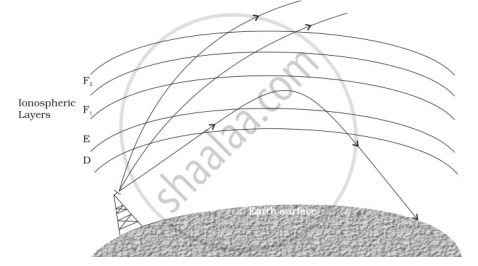Advertisements
Advertisements
Question
Explain with the help of a diagram how long distance communication can be achieved by ionospheric reflection of radio waves.
Solution

In the ionosphere of the Earth’s atmosphere, there are a large number of charged particles (ions). The ionosphere is situated about 65 km − 400 km above the surface of the Earth. The ionization of molecules occurs due to the absorption of the ultraviolet rays and high energy radiation from the Sun. The ionosphere acts as a reflecting layer for certain range of frequencies (3MHz-30MHz). The transmitting antenna sends the EM signals of this frequency range towards the ionosphere. When the EM waves strikes the ionosphere, it is reflected back to the Earth. A receiving antenna at a remote location on the Earth receives these reflected signals.
RELATED QUESTIONS
The outermost layer of the earth’s atmosphere is _______.
(A) stratosphere
(B) mesospher
(C) troposphere
(D) ionosphere
What is space wave propagation?
State the factors which limit its range of propagation
Explain why ground wave communication mode cannot be used for long-distance communication using high frequencies
Four nuclei of an element undergo fusion to form a heavier nucleus, with release of energy. Which of the two – the parent or the daughter nucleus – would have higher binding energy per nucleon?
What is space wave propagation? Which systems of communication use space waves? What is 'radio horizon' of a transmitting antenna of height h? Why is space wave propagation suitable for frequencies above 40 MHz?
Depict the fields diagram of an electromagnetic wave propagating along positive X-axis with its electric field along the Y-axis.
Polarization in e.m wave is caused by
The characteristic impedance of a coaxial cable is of the order of
The maximum frequency for reflection of sky waves from a certain layer of the ionosphere is found to be fmax = 9(Nmax)1/2, where Nmax is the maximum electron density at that layer of the ionosphere. On a certain day, it is observed that signals of frequencies higher than 5 MHz are not received by reflection from the F1 layer of the ionosphere while signals of frequencies higher than 8 MHz are not received by reflection from the F2 layer of the ionosphere. Estimate the maximum electron densities of the F1 and F2 layers on that day.
